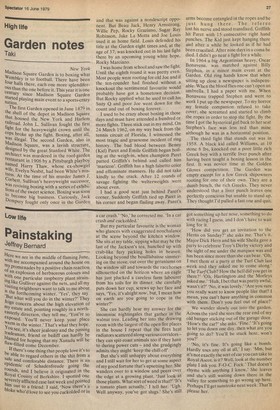Garden notes
Talc!
New York Madison Square Garden is to boxing what Wembley is to football. There have been four halls there, each one more splendiferous than the one before it. This year it is one century since Madison Square Garden started playing main event to a sports-crazy nation. The first Garden opened in June 1879 in the shell of the depot in Madison Square that housed the New York and Harlem railroad. John L. Sullivan fought the first fight for the heavyweight crown until the cops broke up the fight. Boxing, after all, was illegal. The second Garden, also in Madison Square, was a lavish structure, designed by the great Stanford White. The architect was murdered in the roof-garden restaurant in 1906 by a Pittsburgh playboy naMed Harry Thaw, whose ex-showgirl Wife, Evelyn Nesbit, had been White's mistress. At the time of his murder James J. Corbett, Sullivan's heavyweight successor, Was reviving boxing with a series of exlubibons of the sweet science. Boxing was soon to become big business. Curiously, Jack Dempsey fought only once in the Garden and that was against a nondescript opponent. But Beau Jack, Henry Armstrong, Willie Pep, Rocky Graziano, Sugar Ray Robinson, Jake La Motta and Joe Louis used it as home field. Louis defended his title at the Garden eight times and, at the age of 37, was knocked out in his last fight there by an upcoming young white hope, Rocky Marciano. I was home from school and saw the fight. Until the eighth round it was pretty even. Most people were rooting for old Joe and if the ten-rounder had finished without a knockout the sentimental favourite would probably have got a hometown decision. But Rocky applied what he used to call.his Suzy Q and poor Joe went down for the count and out of boxing forever. I used to be crazy about boxing in those days and must have attended a hundred or more fights. Three stick out in my mind. On 24 March 1962, on my way back from the tennis circuit of Florida, I witnessed the most tragic and gruesome incident of ring history. The bad blood between Benny (Kid) Paret and Emile Griffith began boiling at the weigh-in, when champion Paret patted Griffith's behind and called him `maricon'. Griffith has a high falsetto coice and effeminate manners. He did not take kindly to the crack. After 12 rounds of savage fighting the welterweights were about even.
I had a good seat just behind Paret's corner. Suddenly Griffith tied up Paret in his corner and began flailing away. Paret's arms become entangled in the ropes and he just hung there. The referee lost his nerve and stood transfixed. Griffith hit Paret with 15 consecutive right hand punches. The Kid just kept hanging there and after a while he looked as if he had been crucified. After nine days in a coma he died. I didn't go near a fight for a while.
In 1964 a big Argentinian heavy, Oscar Bonavena, was matched against Billy Stephen, in a minor main event at the Garden. Old ring hands know that when sitting up close a newspaper is indispensable. When the blood flies one can't open an umbrella. I had a paper with me. When Bonavena trapped Stephen and went to work I put up the newspaper. To my horror my female companion refused to take cover; she screamed and started to climb the ropes in order to stop the fight. By the time I got the hysterical girl back to her seat Stephen's face was less red than mine although he was in a horizontal position.
The third fight that stands out was in 1958. A black kid called Williams, at 10 stone 6 lbs, knocked out a poor little rich Greek boy with a terrific liver punch after having been taught a boxing lesson in the first. It was novice time at the Golden Gloves competition. The Garden was empty except for a few Greek shipowners rooting for one of their own. They are a dumb bunch, the rich Greeks. They never understood that a liver punch leaves one perfectly conscious but unable to stand up. They thought I'd pulled a fast one and quit.


































 Previous page
Previous page